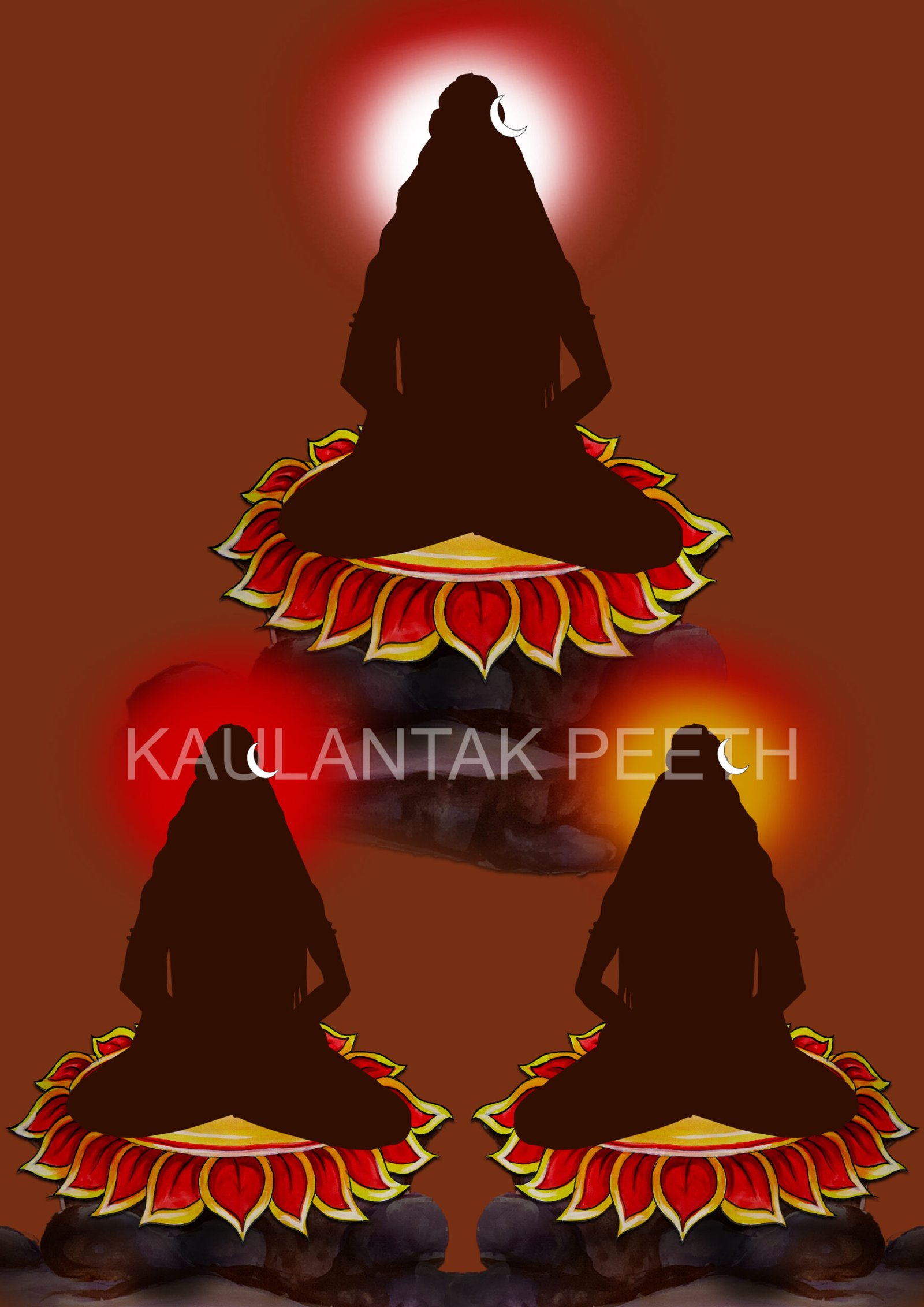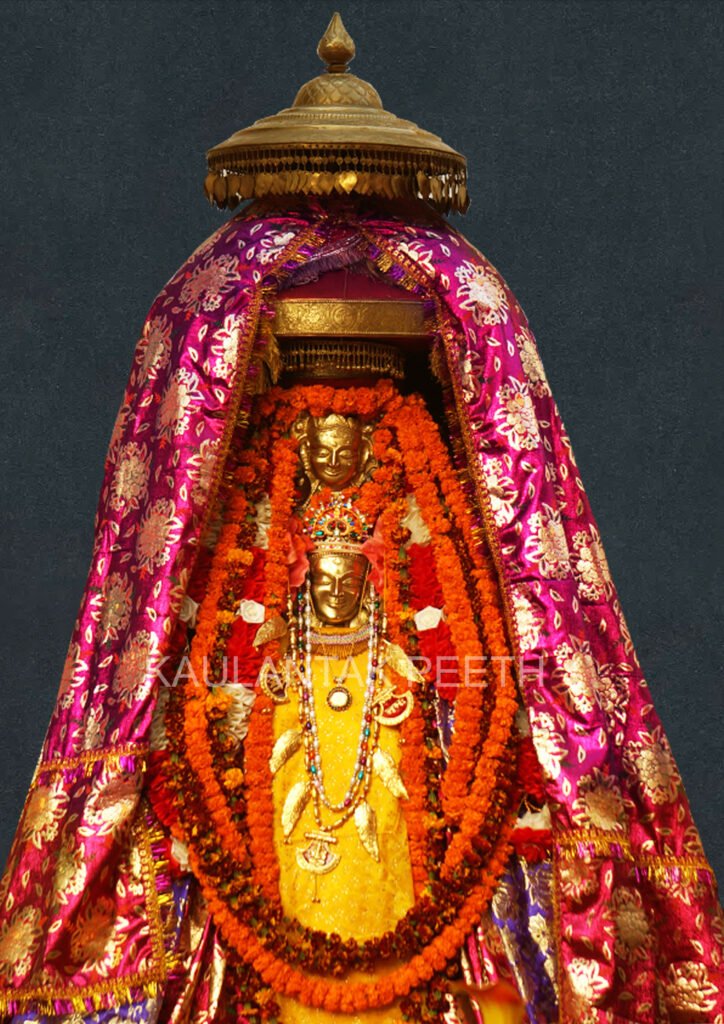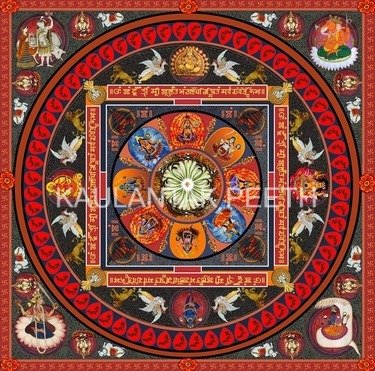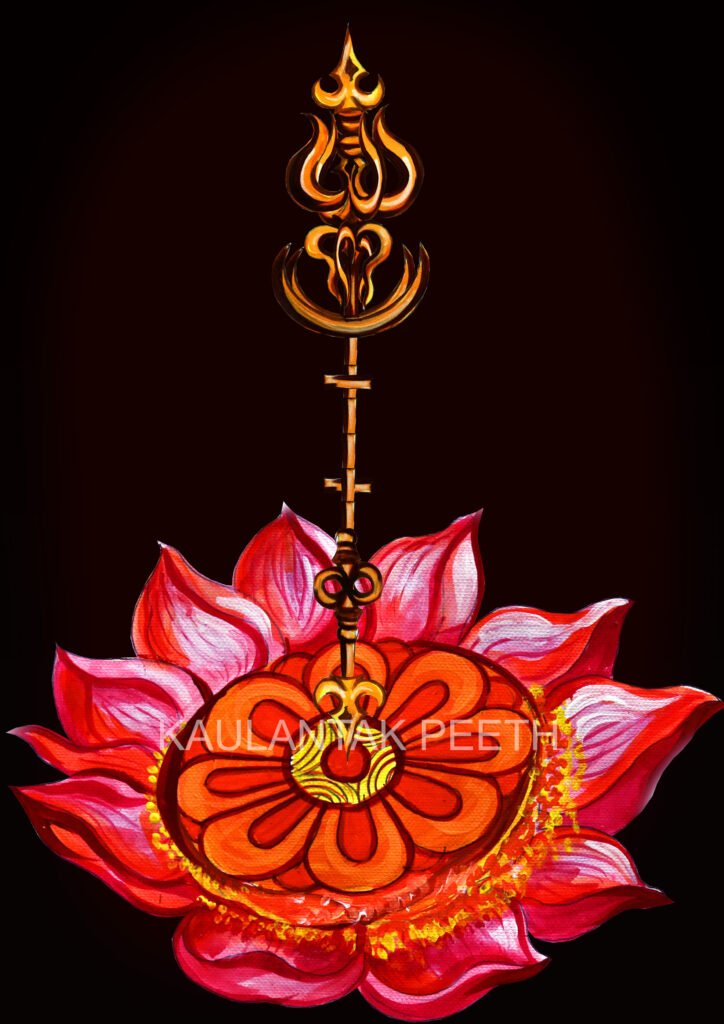‘Tri Siddhatva Patala’ is the seventh ‘Patala’ of the foundational Granth of Siddha Dharma called ‘Deva Samadhi Tantra’. It is written by Mahasiddha Gana Chakra Nath (महासिद्ध गण चक्र नाथ ).
‘Tri Siddhatva Patala’ is a combination of three words, where ‘Tri’ means three, ‘Siddhatva’ refers to the highest state of enlightenment in the tradition of Siddha Dharma, while ‘Patala’ means chapter. It is the chapter under ‘Deva Samadhi Tantra’ that defines three kinds of states of ‘Siddhatva’. The three types of ‘Siddhatva’ defined in this chapter are ‘Siddhanta Siddhatva’, ‘Maya Siddhatva’ and ‘Mukta Siddhatva’. ‘Tri Siddhatva’ are the three paths to attain the state of great enlightenment called ‘Siddhatva’. After attaining the state of ‘Siddhatva’ through any of these three ways, the Siddha progresses further into the ‘Siddhatvopari Awastha’ which is also called as the state of ‘Mahasiddhatva’. The Yogi who attains the state of ‘Mahasiddhatva’ is called the ‘Mahasiddha’.
The three paths under the school of ‘Tri-Siddhatva’ are ‘Siddhanta Siddhatva’, ‘Maya Siddhatva’ and ‘Mukta Siddhatva’. ‘Siddhant Siddhatva’ means when one moves towards ‘Siddhatva’ through Gyan Maarg. ‘Maya Siddhatva’ is the path, when one moves towards Siddhatva while living in Samsara, fulfilling the duties of Samsaric life while practising Siddha Dharma to attain Siddhatva. While ‘Mukta Siddhatva’ refers to the path to Siddhatva, where one leaves philosophy and worldly life behind and practices Siddha Dharma. Under ‘Mukta Siddhatva’, a disciple chooses the path of deep ‘Tapa’ to attain the state of Siddhatva. The ‘Tri Siddhatva Patala’ is the compilation of many Sutras.
The Sutras in ‘Tri Siddhatva Patala’ are considered as the foundational education that comprises the practice system to attain Siddhatva. In this ‘Patala’ there are more practice techniques than theory and philosophy. ‘Tri Siddhatva Patala’ presents mostly the Yogic and Tantric practice techniques along with various ‘Dharana’ (visualisation), Mantra, Sacred Geometry and Mudra practices.
History of Tri-Siddhatva Patala
According to Siddha Dharma, in the beginning, when the wisdom systems lagged behind a definite structure, the Siddhas used to practice the Sadhana Marg in Siddha Dharma without a well-defined system. The education system lagged in uniformity to attain the state of highest level of enlightenment- ‘Siddhatva’. Therefore, in those times, the Mahasiddhas gave the education and Sadhana practices according to the interest and mindset of the disciple.
Then the Tri-Adi-Mahasiddhas appeared in the tradition of Siddha Dharma. They were revolutionary in their ways. They founded their own schools. The Tri-Mahasiddhas attracted and impacted thousands of Sadhaks from around the world. The three Adi-Mahasiddhas are:
- Mahasiddha Vyaghravritta Nath- also known as Vyaghrambara Nath.
- Mahasiddha Agnivritta Nath
- Mahasiddha Koshir Nath- also known as Kopa Shirsha Nath
Mahasiddha Vyaghravritta Nath established the path of ‘Siddhanta Siddhatva’. Mahasiddha Agnivritta Nath established the path of Maya Siddhatva. While Mahasiddha Kosher Nath established the path of Mukta Siddhatva.
Once a great debate happened amongst the Tri-Mahasiddhas about which is the best path to attain Siddhatva amongst the three ways to attain Siddhatva. Mahasiddha Kosher Nath won this great debate. But there were one thousand ‘Bhu Ganas’ ( ‘Bhu Gana’ is the head of a village community) who were not satisfied with the debate. So they invited Mahasiddha Kosher Nath to debate with all of them in order to satisfy them. Then Mahasiddha Kosher Nath ji debated with the ‘Bhu-Ganas’ and won that debate also. For this reason, he was bestowed with the title of ‘Gana Chakra Nath’. ‘Gana Chakra’ means who won one thousand Bhu-Ganas in the debate.
Although Mahasiddha Kosher Nath ji also known as Mahasiddha Gana Chakra Nath ji, won the debate, he realised that if he refuted the other two paths to Siddhatva founded by Mahasiddha Vyaghravritta Nath and Mahasiddha Agnivritta Nath ji, then Siddha Dharma would witness a great loss. The other two paths of ‘Siddhanta Siddhatva’ and ‘Maya Siddhatva’ were also complete paths to attain Siddhatva. Therefore, together with the other two Mahasiddhas, Mahasiddha Kosher Nath ji restructured the paths of Tri-Siddhatva and united them under Deva Dharma. The three paths then came to be known as ‘Deva-Dharmokta TriSiddhatva’.
According to the head of Kaulantak Peeth (Kulant Peeth), Mahasiddha Ishaputra, “A student of Siddha Dharma must develop few virtues to attain the state of Tri-Siddhatva. One is to give up the ‘Ahankar Bhav’ (ego) and the other is to rise above ignorance and attain knowledge. The great Tri- Adi- Mahasiddhas held debates not to prove their individual greatness, but to show the glory of their education system to attain the state of Siddhatva. Mahasiddhas never do anything to prove their point. Later the three Mahasiddhas restructured the entire education system under ‘Tri Siddhatva’ to improve it and to bring uniformity across the entire education system to attain the state of Siddhatva.”
Deva Dharmokta Tri-Siddhatva
Siddhanta Siddhatva
After unifying the school of Tri-Siddhatva, Mahasiddha Vyaghravritta Nath ji gave six steps to attain Siddhanta Siddhatva. The school of ‘Siddhanta Siddhatva’ represents the time period of ‘Bhoot Kala’ (past). They say that past can’t be forgotten. Because without past, present don’t exist. It is like the tree whose roots are hidden under the ground. The tree one sees is the present and the hidden roots are the past.
Below is the table that enumerates the chapters under ‘Tri-Siddhatva’
| SL No. | Name of Chapter | Sutras |
|---|---|---|
| 1 | Sahaja Siddhatva | 16 |
| 2 | Sanyoga Siddhatva | 21 |
| 3 | Shiksha Siddhatva | 18 |
| 4 | Gyan Siddhatva | 21 |
| 5 | Nyaya Siddhatva | 12 |
| 6 | Deva Siddhatva | 11 |
Maya Siddhatva
After unifying the school of Tri-Siddhatva, Mahasiddha Agnivritta Nath ji gave six steps to attain Maya Siddhatva. The school of ‘Maya Siddhatva’ represents the time period of ‘Vartamaan Kala’ (present time). Mahasiddha Agnivritta Nath ji said that the present moment is the seed of a fine past and fine future. One must focus completely on the present time and do what is needed to make it best. The present moment will become past in the next moment. And the next moment in the future will become present soon.
Mahasiddhas give the example of a person standing on a mountain peak with a hammer. If the person decides in that moment to jump off from the mountain peak, he will die in those moments. But if he decides to break the stones on the mountain peak, then the mountain peak will begin to decrease with the breaking of its stone at that very moment.
| SL No. | Name of Chapter | Sutras |
|---|---|---|
| 1 | Dukha Bodh Siddhatva | 11 |
| 2 | Agyan Bodh Siddhatva | 21 |
| 3 | Aksham Bodh Siddhatva | 16 |
| 4 | Parishram Bodh Siddhatva | 17 |
| 5 | Prapti Bodh Siddhatva | 10 |
| 6 | Sukh Bodh Siddhatva | 9 |
Mukta Siddhatva
After unifying the school of Tri-Siddhatva, Mahasiddha Kosher Nath ji gave six steps to attain Mukta Siddhatva. The school of ‘Mukta Siddhatva’ represents ‘Bhavishya Kaal’ (future time). Mahasiddha Kosher Nath ji said that a person must keep an attentive eye on the future. Because one doesn’t know when the future becomes present.
For example, when a person is walking in jungle with the eyes on the way ahead and catch a glimpse of a tiger far ahead and think that he will see how the situation is after few moments, then his life is in danger. Because tiger is extremely fast predator. The person won’t realise that the future moment he is waiting for to take action for self-defence can become present at any moment resulting in his death. So one must have an extremely attentive eye towards the future and keep the ‘Shastra’ (weapon) ready to face the tiger.
| SL No. | Name of Chapter | Sutras |
|---|---|---|
| 1 | Gyan Siddhatva | 18 |
| 2 | Sookshma Siddhatva | 8 |
| 3 | Deva Siddhatva | 22 |
| 4 | Maha Siddhatva | 9 |
| 5 | Siddhasetu | 33 |
| 6 | Siddhatvopari | 8 |
Goal of Tri-Siddhatva Patala
This ‘Patala’ of ‘Deva Samadhi Tantra’ aims to present the knowledge about the state of ‘Siddhatva’ and different ways to attain ‘Siddhatva’ and ‘Mahasiddhatva’ to a Sadhak of Siddha Dharma tradition. Second is to inspire and equip a disciple to develop a mindset to be a Siddha and rise beyond all the ‘Sukha’ (joys) and ‘Dukhas’ (sufferings). The word ‘Siddha’ ( Sanskrit: सिद्ध ) means the ‘perfected one’.
Siddhas divided the state of ‘Siddhatva’ into three parts. The reason being that if every person is against ‘Prithvi’ (our planet Earth) and stands against the Jati Dharma (Laws for Human Life) of this planet, then the beautiful human life will come to an end in the Universe. Therefore the difference existed amongst the different Siddhas about whether they should think about the above mentioned viewpoint or not. Some Siddhas said that ‘Brahm’ is everything. So even if this ‘Prithvi’ (planet Earth) comes to an end, i.e become ‘Shoonya’, which is bound to happen one day, then it is just a matter of attachment that humans and the human civilisation should go on, on this planet. So we must avoid this attachment.
The other Siddhas said that it is due to the ‘Iccha’ (desire) of ‘Brahm’ that all the ‘Jeeva’ (beings), who are ultimately part of ‘Brahm’ are created through Maya. Therefore we must not mock or insult life on this Earth. When such viewpoints are presented, especially when the children begin to receive knowledge about the state of ‘Siddhatva’ in the ‘Gurukulas’, it becomes paramount to teach them about the three states of ‘Siddhatva’.
The goal of ‘Tri Siddhatva’ is that it works like steps for any disciple to understand the states of ‘Siddhatva’ step by step, before attaining the deep state of Siddhatva. The important thing to note here is that, it teaches us that the Siddhas should attain the state of highest enlightenment while respecting every place, time, object and situation.
This ‘Patala’ aims to prepare the disciples in the lineage of Siddha Dharma in a way that they should not disrespect this ‘Srishti’ (creation), thoughts and choose a common way, where they don’t disrespect anyone in this paradoxical world and move forward towards the state of ‘Siddhatva’ by being acceptable to everyone.
The colour of school of ‘Siddhanta Siddhatva’ is mustard yellow. Maroon is the colour of school of ‘Maya Siddhatva’. White is the colour of school of ‘Mukta Siddhatva’. If the ‘Teja Chakra’ (Divine Halo) of a Mahasiddha is represented in mustard Yellow, that Mahasiddha mastered ‘Siddhanta Siddhatva’. If the ‘Teja Chakra’ (Divine Halo) of a Mahasiddha is represented in Maroon, that Mahasiddha mastered the ‘Maya Siddhatva’. If the ‘Teja Chakra’ of a Mahasiddha is represented in White, that Mahasiddha mastered ‘Mukta Siddhatva’. If the ‘Teja Chakra’ of a Mahasiddha is represented in three colors, that Mahasiddha is the master of the paths of ‘Tri Siddhatva’. If the ‘Teja Chakra’ of a Mahasiddha is represented in multi-colours, that Mahasiddha has mastered the Siddhatvopari state.






